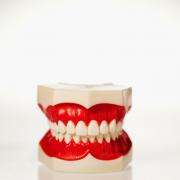Making crowns stick to teeth more effectively

Dentists want those expensive crowns to stick to the teeth. But it doesn’t always happen because of contamination during the crown’s bonding.
Jin-Ho Phark, an assistant professor of comprehensive care at the Case Western Reserve University School of Dental Medicine, says another factor plays into a crown’s durability. He discovered that the type of surface that the adhesive clings to has an important role. A smooth interior crown surface tends to sheer off easier than one with a rough texture.
By using an x-ray photoelectron spectroscopy (XPS) imaging system in the lab of Harold Kahn, a professor at the Case School of Engineering—the same kind of system used by CSI on television—Phark was able to detect what contaminants clung to the crown surface. This research overturns the thinking about what is the gold standard or best practices in placing crowns, says Phark.
Crowns are made of aluminum-oxide or zirconium-oxide ceramic due to the strength of the materials and to simulate the look of natural teeth. The crowns are first milled from ceramic blocks using CAD/CAM technology. They are then set onto a tooth model to be adjusted to the final shape and shade in a procedure called “veneering” with another ceramic material. The models are made of plaster from a mold of the patient’s tooth. In the veneering process, the crown can be contaminated from the model’s plaster. Those tiny plaster particles can corrupt the bonding agent.
The plaster contamination, along with saliva and blood during the fitting procedure before permanently attaching the crown, can cause gaps in the adhesive between the tooth and crown and weaken the bond, says Phark.
Over time, secondary decay can occur at the margin of the crown or weakness can develop as the crown ages from the stress of biting and temperature changes.
With Kahn's help, Phark tested a new ceramic crown material developed and donated for testing by the Swedish company Nobel Biocare, a world leader in innovative restorative and esthetic dental solutions.
This product is fabricated in a new heating process to create a very rough surface texture on the inside of the crown where the bond agent is applied before affixing the crown to the tooth. Plaster or blood and saliva can become trapped in the valleys of the new surface. But during the veneering procedure excess plaster particles are burned off to prevent contamination. The etching of the interior crown surface with an acid before attaching it to the tooth also removes the blood and saliva.
Phark says the “gold standard” in attaching aluminum- and zirconium-oxide crowns has been to blast the interior of the crown with sand particles to roughen the surface and then to attach it with a special cement. But sandblasting may weaken the ceramic material.
“This new crown comes prepared and does not need the extra sandblasting treatment by a dental technician,” says Phark. It can be also attached with normal cements.
Phark’s research won the International Association of Dental Research Award for new investigators in the area of biomaterials. Collaborating on the project were Kahn and Sillas Duarte and Avishai Sadan from the Department of Comprehensive Care at the dental school and Markus Blatz from the Department of Preventive and Restorative Sciences at the University of Pennsylvania.
Provided by Case Western Reserve University (news : web)

















